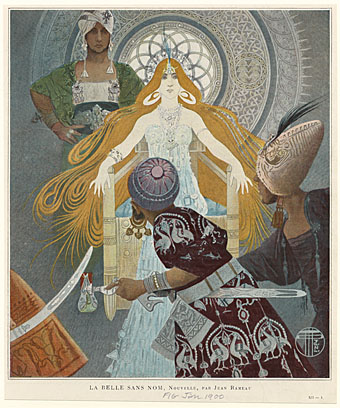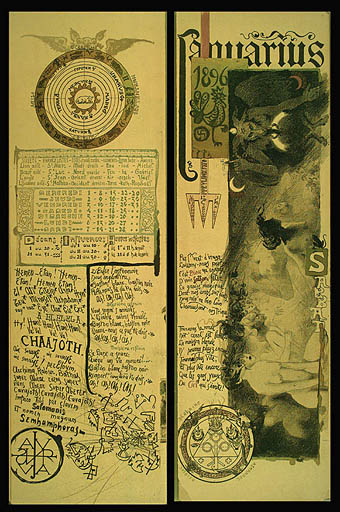La belle sans nom (1900).
An illustration by French artist Manuel Orazi (1860–1934) from Figaro illustré for a story by Jean Rameau. Via NYPL Digital Gallery. It’s good to see something else by Orazi other than advertising illustration. His astonishing work for Austin De Croze’s 1895 Calendrier Magique (below) can be seen in full at the Cornell collection. Great graphics for Halloween.
Elsewhere on { feuilleton }
• The illustrators archive
Previously on { feuilleton }
• The Feminine Sphinx
• Le Monstre
• Carlos Schwabe’s Fleurs du Mal
• Empusa



How come there are Zoetic sigils on this calendar and one of Spare’s automatic drawings on the October page? I note that the author is another Austin, which leads me to think this a modern amalgam incorporating Orazi’s original artwork. Or am I just missing the point?
Actually, I just got the point… the previous owner just scribbled his own occult doodles onto it, right? I was having a blonde moment before!
Hi Dave. Given that this item is owned by Cornell University Library I think we can assume they’re accurate with its provenance. Both author and artist are genuine persons of the period with much work in other areas. They both worked for Figaro as well.
As far as I can tell, the doodles are part of the work itself. I think you may be reading too much Spare-ness into its appearance. Those “Zoetic” motifs correspond to the months in question–so Augustus, for example, has a motif made of those letters (with V for U). It’s either coincidence that Orazi’s graphics prefigure Spare’s more serious designs. Or–using Occam’s Razor–it’s not beyond the bounds of possibility that Spare saw or even owned a copy of this calendar himself and took the idea from there. He was 9-years-old when it was published; copies could have been around when he started looking for occult texts a few years later. Having seen copies of Spare’s own magazines I’m sure he would have been attracted by the drawings.
Hi John. Yes, I’m sure you’re right. My initial thought was that the doodles were, indeed, part of the design, but when I saw that cursive pen-style beastie on the October page it seemed a strange coincidence. My idea last night was that although Cornell own the document, it may only have come to them recently after being embellished by a previous owner.
Looking at it again this morning I’m inclined to think that Mr Spare probably saw a copy – he certainly wasn’t above stealing ideas from other graphic artists. There are strong similarities between his Earth Inferno drawings and Edmund J Sullivan’s work, eg ‘The Bedlam of Creation’ from Sartor Resartus and ‘The Scientist at Work’, which I believe to be the initial inspiration for Spare’s 1907 ‘Death Posture’ self portrait, which in turn inspired Harry Clarke’s portrait of Edgar Allen Poe.
While I’m on the subject, I was lucky enough to see the frontispiece from The Focus of Life in Manchester earlier this year and was stunned by the quality of line and how ill-served it is by reproduction. It was also gratifying to note that of all the artworks in that show, it was Spare’s that attracted the most comment and biggest crowds, at least on the day of my visit.
That’s interesting about Spare’s sources–something I hadn’t spotted myself–and it backs up my opinion that some serious art (as opposed to occult) study needs to be given to Spare’s work. Art critics ignore or dismiss his occult concerns while occultists often marginalise his artistic achievements, failing to see them in a broader context.
Complete fabulosity.
Heh, I thought you’d like this!